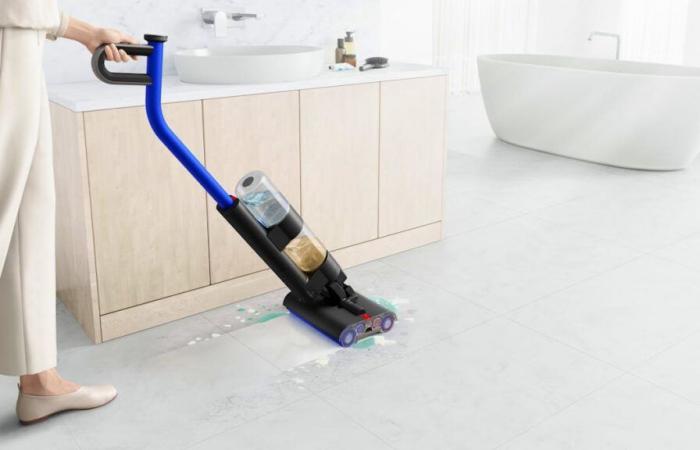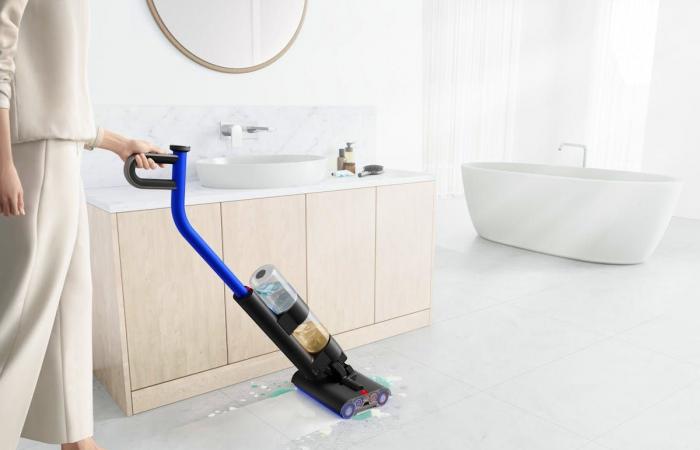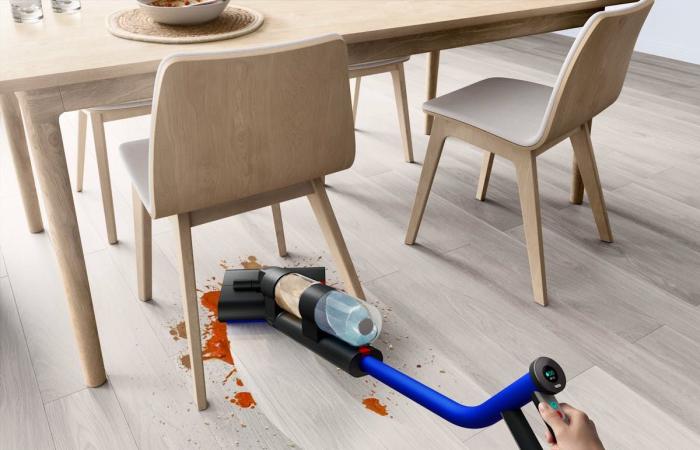The Dyson G1 in action in a too-good-to-be-true bathroom.
Dyson.
From Dyson, we especially knew vacuum cleaners and their particularities. That of not being given is one of them. That of having a unique design, recognizable among all, is another. The British manufacturer has taken a small step forward in recent weeks by introducing, in Switzerland and elsewhere, a new model, the WashG1. The latter has the specificity of not being a vacuum cleaner, but a hydrating floor cleaner.
The device is therefore designed to wash hard surfaces in a home. Better than a panosse and its bucket, that goes without saying. After a few weeks of testing, here’s what we can say about it.
The WashG1 runs on battery power. It recharges as soon as it is placed on its base connected to the electrical network. It has a base made up of four brushes. Two are in direct contact with the ground and two others are designed to separate any waste that may have stuck to the rollers and ensure that it is dumped into the appropriate removable receptacle. Its autonomy is very good, we were never caught off guard.
One liter capacity
This base is humidified by a tank which we have taken care to fill with tap water (capacity of approximately one liter) and a network of pipes. Water that does not end up on the ground is collected and discharged into the dirty water tank. As in a closed circuit of sorts. Once the brush has passed, the floor appears cleaned, a slight veil of damp remaining being expected to evaporate quickly. We note that we were not bothered in any way by an overly moist soil which would take too long to dry.

The device is designed to easily pass under furniture. Even quite low.
Dyson
At the top of the handle is the control station, featuring a small circular screen and three buttons. One to turn the power on or off, the other to select the intensity of humidification, a last one for variable use depending on what the screen displays.
Basically, we fill the tank, we bring everything to the desired location, we select the intensity of humidification (one, two or three), we launch the bousin, we print the back and forth movement. comes necessary and we admire the work. Moderately dirty floors immediately become spotless, those with more stubborn marks require more passes and sometimes pressing the “turbo” button which temporarily intensifies the water injection. Solid waste is collected and falls into the receptacle. The latter can easily be extracted to be emptied and cleaned under tap water whenever we want. Simple, flexible, easy.
During the first use, we took care to put the interface in French. We also took the trouble to install the MyDyson application on our smartphone, which offers lots of things, including device registration, instructions for use, maintenance advice, etc.
In addition to the waste container, the brushes are easily removable and therefore cleanable. They can be replaced by new ones which must be purchased in store (online or otherwise) after more than 24 hours of cumulative use.
We note that each time the broom returns to its base, a self-cleaning procedure for the brushes is initiated. However, this does not spare us the duty of emptying the small receptacle of its waste and the two water tanks.
A video that explains how the WashG1 works.
Dyson.
In use, we notice that WashG1 hums the slightest, but without the ears really suffering. The way water is injected and then recovered is fascinating. We can guess that a lot of engineering work was done to achieve this simplicity and efficiency without necessarily putting a lot of effort into it. We also see that the use of G1 does not really make sense on small surfaces. The object is rather designed for large spaces, as shown in the demonstration videos. Taking it when, for example, you only have a small kitchen to clean would be a waste.
We operated the WashG1 without adding detergent to the water tank. Quite simply because we didn’t feel the need. This remains possible, indicates the manufacturer, as long as the product is not too foamy.
The remaining questions relate to the long-term reliability of the hydraulic network and the durability of the rotating microfiber brushes. For now, we are far from having pushed the machine to its limits over time. Our feeling remains very positive at this stage.
A price around 700 francs
In the end, here is a product cleverly designed for homes mainly equipped with hard floors (catelles or parquets). Homes especially equipped with rugs or carpets can easily do without them.
Its price, around 700 francs, hardly surprises us given the brand’s habits of taking care of the eyes as much as the functionalities.








